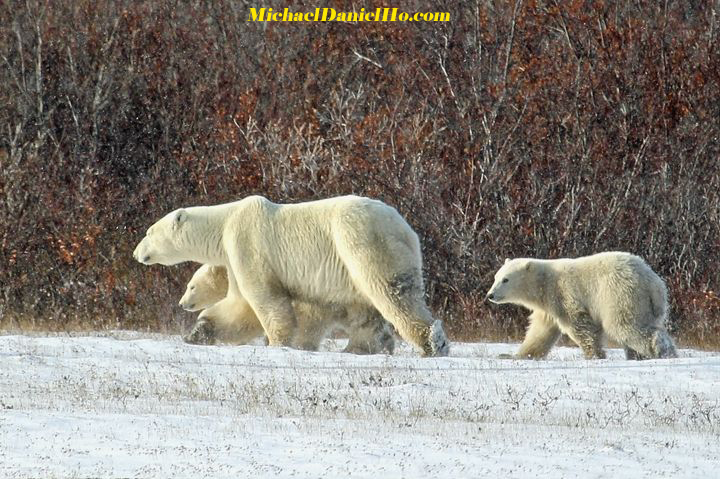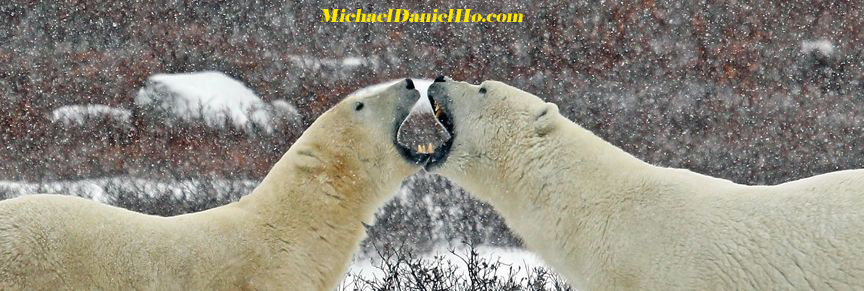Wildlife photographer Michael Daniel Ho just returned from a polar bear adventure in Canada! He generously shared some stellar photos and took time to answer a few questions about his trip. After reading his answers, you will most likely add “seeing polar bears” to your bucket list. Just bring lots of warm layers along, Michael said it was very, very cold…
Q. How were you able to get such amazing photos of polar bears?
A. There are only five nations with polar bear populations: the US, Canada, Russia, Norway and Denmark (Greenland). I chose Hudson Bay, Canada because they have the most studied polar bear population in the world and I wanted to understand how they have been progressing under strict scientific monitoring for the last few decades. The bears are hanging around the frozen shore line of the bay waiting for the big freeze. I went out on a big tundra vehicle and the bears are very curious and have no fear of the vehicle or people. They will not flee at the sight of humans, like most black bears and some brown bears. Polar bears will come up to the vehicle and inspect it.
Q. Are polar bears really in trouble from climate change?
A. The poles are definitely warming. This can be readily confirmed by comparing satellite photos from years past. This is a simple fact although some may still debate why the earth is warming. The sea ice is forming later and later and melting earlier and earlier. This poses a very big problem for polar bears, especially mothers with cubs because they need the frozen ice to hunt seals and that is their main food source for survival. Although polar bears are classified as marine mammals, they are not fish. If they are forced to swim further and further for their food, they will get too tired and eventually drown, especially the cubs.

Photo credit: Michael Daniel Ho
Q. How do polar bears spend their days?
A. In the summer and autumn months when there is no sea ice for the bears to hunt on, there is simply nothing for them to do. The enterprising ones may try and forage for some plants and seek out animal or whale carcasses but most of them will have to go on a forced diet and go without food for months. They used to feed for about 6 months and diet for the rest of the year. Now the ratio for Canadian polar bears is more like 4 to 5 months of feeding and 7 to 8 months of famine. The receding Polar ice caps will affect the bears in all five nations since they are all dependent on frozen ice to hunt and feed.
Q. What is the most interesting fun fact about polar bears you learned?
A. Firstly, polar bears are so cute and fun to observe and photograph. They are curious and can be quite sociable even though they are generally loners when they go hunting on the ice. Secondly, they are great long distance swimmers, although all bears can swim to a certain degree. However, polar bears are not fish. They are air breathing mammals and their swimming marathons are only sustainable if they have enough food. If not, they will eventually drown or risk getting get attacked by sharks or orcas when they are too far out in the ocean.

Photo credit: Michael Daniel Ho
Q. What makes polar bears different from other bears?
A. About 150,000 years ago, some brown bears migrated up to the Polar region of the Arctic and stayed. Over the course of many millennium, they evolved into their present thick ‘white’ color coat, longer necks and elongated heads with small ears. They became totally adapted for life in the Arctic and hunted seals exclusively. Now they will not survive without the sea ice and seals. Fortunately, their predominant prey, the ringed and bearded seals exist in healthy numbers, provided the sea ice is there for them to rest and give birth.
Q. If you wanted us to remember one thing about polar bears, what would it be?
A. The polar bear is an iconic symbol of our fragile planet. They are a magnificent and unique species of bear that is in decline due to the warming of the earth and hunting by indigenous people for food and profit. If the rise of global temperature is not reversed and the management of their population deteriorates, polar bears may not survive for future generations to appreciate and marvel.
For more great polar bear facts, photos and stories about Michael’s trip to Canada, visit his website and blog. Polar bears are listed as “threatened” under the Endandered Species Act; the National Wildlife Federation provides detailed information on polar bears and their status.

For those who love Polar Bears and the environment, I highly recommend the IMAX film ‘Into The Arctic’. I saw it recently in its IMAX, jaw-dropping glory and was impressed by the cinematography and its unbiased presentation of the plight of Polar bears and their habitat, namely the Arctic.
Amazing. Thanks, OWT and Michael!